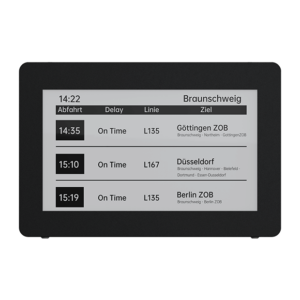E Paper Displays: The Perfect Blend of Clarity and Efficiency
E Paper Displays: The Perfect Blend of Clarity and Efficiency
Blog Article
E Paper Displays: Enhancing Visual Comfort and Functionality for Modern Use
In today's electronic era, wherever screens are omnipresent, e-paper exhibits are creating dunes using their innovative approach to visible technology. Unlike traditional LCD screens that demand constant energy to keep exposure, e ink display offer a unique mixture of understanding and performance, creating them significantly popular in a variety of applications. This article dives to the wonders of e-paper engineering, exploring its benefits and possible uses.
Knowledge E-Paper Technology
E-paper, or electronic paper, mimics the appearance of standard ink on paper. It reflects gentle the same as real paper, which makes it simpler on the eyes in comparison to backlit screens. That feature is particularly useful for extended examining, since it minimizes attention strain. The technology behind e-paper requires small pills full of charged particles that shift when a power area is used, creating text and images.

One of the standout great things about e-paper shows is their energy efficiency. Unlike mainstream monitors that want constant power, e-paper just employs energy when adjusting the display. Which means when an image or text is defined, it stays obvious without eating extra energy. Therefore, products with e-paper may provide somewhat longer battery life, which explains why e-readers and some electronic signage programs prefer that technology.
Additionally, e-paper exhibits offer extraordinary visibility in direct sunlight, a thing that old-fashioned screens battle with. This makes them ideal for outdoor use, where quality is essential. The absence of glare guarantees that customers can pleasantly study or view content without having to squint or seek shade.
Applications Across Industries
E-paper shows are finding a solid foothold in the e-reader market. Units like the Kindle use e-paper to offer customers with an experience comparable to studying a physical book. This not only makes reading relaxed around lengthy intervals but also allows these devices to last days about the same charge.
Beyond e-readers, e-paper engineering is being investigated in different sectors. Retailers use e-paper costs to dynamically update rates minus the waste of report or the problem of information changes. This not just increases detailed efficiency but in addition aligns with sustainability objectives by reducing report waste.
Transportation is still another market benefiting from e-paper displays. Envision bus prevents designed with e-paper timetables that update in real-time, offering commuters regular information without the energy burden of old-fashioned electronic screens. Such programs are not just innovative ideas but are already being implemented in several towns worldwide.

The Potential of E-Paper Features
The long run looks bright for e-paper technology. With continuous breakthroughs, we are able to expect even greater quality and color capabilities. This will open new possibilities, making e-paper suited to a larger selection of applications, including knowledge, marketing, and beyond.
In conclusion, e-paper features offer the perfect balance of quality and energy efficiency. Their capacity to supply an almost paper-like studying experience while conserving energy makes them a stylish selection for various industries. As engineering remains to evolve, e-paper is set to enjoy a far more substantial position in our digital landscape, promising a greener and better future. Report this page